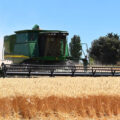By Alice Miller BVSC DBR MRCVS
Friars Moor Livestock Health
We share our farmers’ concerns as we continue to experience extraordinary drought conditions across the UK. The Met Office reports an average rainfall of only 15.8mm (0.6in) across England for this last month, making it the second driest July since records began in 1836. This is just 24 per cent of the total rainfall expected for an average July. Many grass fields are looking barren as growth has reduced, or completely stopped. This presents worrying challenges for all livestock keepers who are figuring out how best to support the nutritional requirements of their flocks and herds.
It is important to also consider that animals with limited feed sources will be forced to forage for alternatives. If animals have no other option they will eat from unsuitable hedgerows, ditches and verges, where ordinarily they would leave these often-unpalatable plants alone. As a result, it is not uncommon to see problems due to plant poisonings.
Many farmers are already buffer feeding to mitigate for the low volume and lack of nutritional value in the grass. Hopefully with good early cut forage available there are options other than drawing out insufficient grazing. It is important to discuss your flock and herd requirements with your nutritionist first. One of the biggest concerns is ensuring you have enough supplies to see you through the winter. So, it is vital you plan now. When increasing concentrate levels, it is important to only feed what is required as a supplement or instead it ends up as an expensive substitute. For example, when concentrates are fed and grass is available, cows will eat less grass, so the grass quality will just deteriorate if too high a residual is left. It is also important to monitor for signs of acidosis. Prevent acidosis by avoiding sudden dietary changes and by limiting the volume of concentrates fed at once.
It is important to monitor production to establish the impact the drought is having on your herd and flock. Regular body condition scoring of adult animals and regular weighing of youngstock, and animals intended for breeding or finishing, will help establish growth rate trends. It is important to mitigate these losses sooner rather than later, since the knock-on effects can be long-lasting. It takes much longer for animals to regain weight than lose it. We want to avoid reduced finishing weights and extended rearing times. In turn if heifers are not meeting body weight targets for breeding, they will be older by the time they calve in. Higher age at first calving has a long-term impact on the efficiency of the system as well as affecting the lifetime production capabilities of that animal. Nutritional stress will also reduce milk yields and impact animal health and fertility, with an increased risk of cystic cows as well as reduced cyclicity seen.
Practically, your vets and nutritionist are more than happy to help advise you further, but it is also important to remember you are not alone in this, and if you wish to discuss financial or mental health support, the Royal Agricultural Benevolent Institution (RABI) and the Farming Community Network (FCN) are great places to start.











Leave a Reply